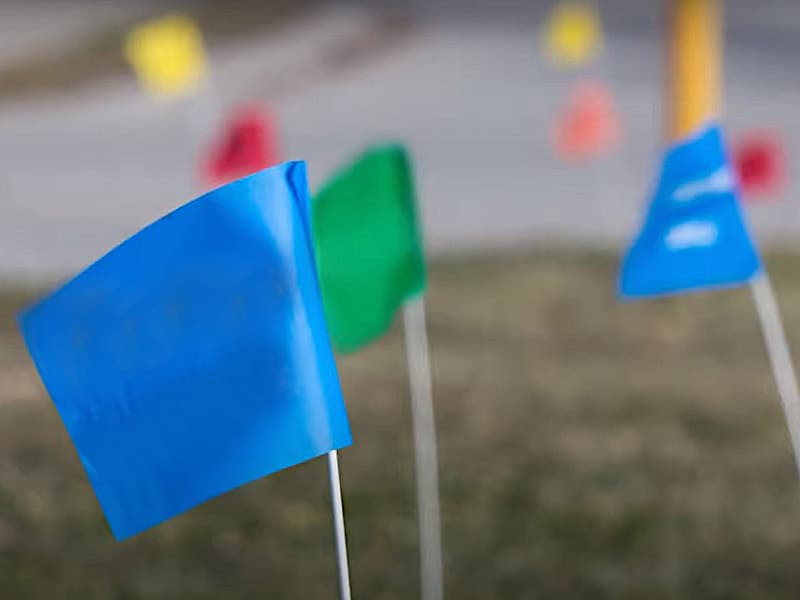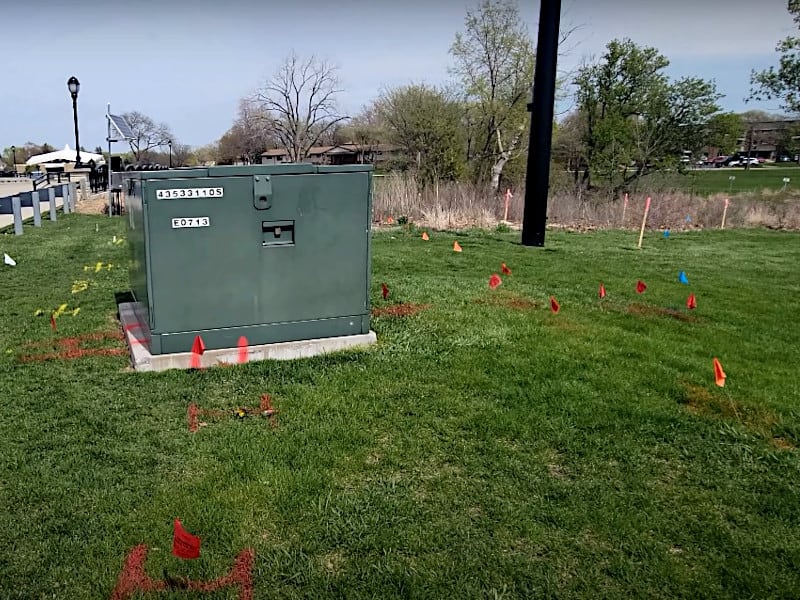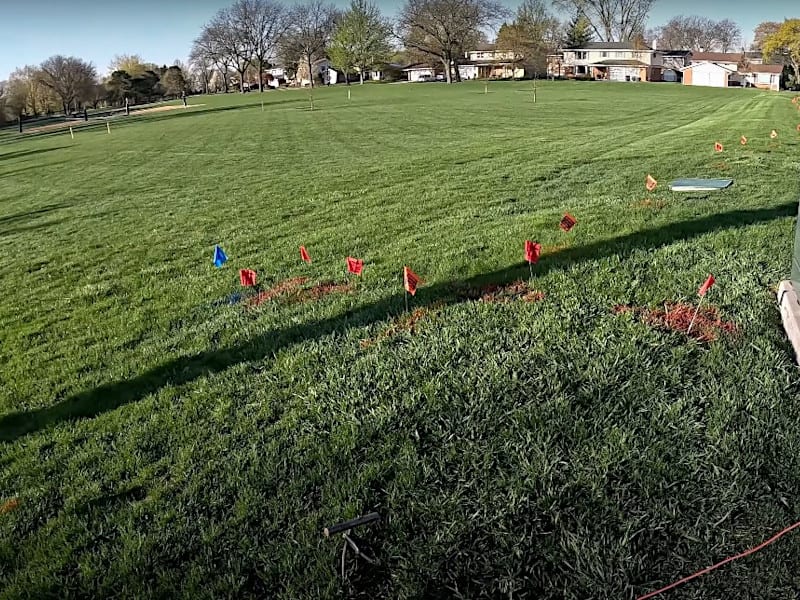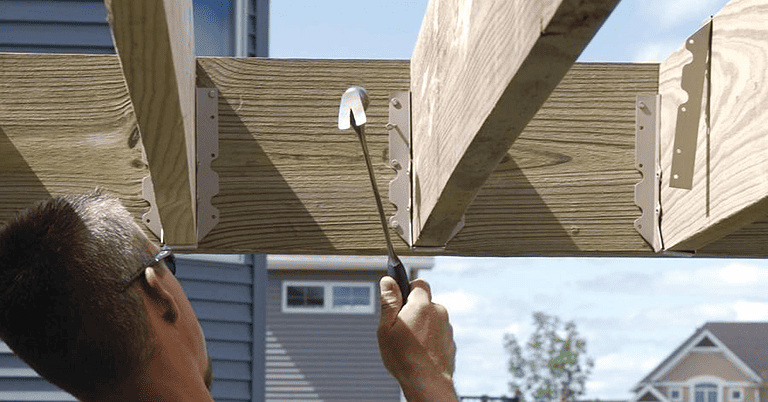When Can I Remove Utility Flags in My Yard
Have you ever wondered when you can remove those utility flags that have been sticking out of your yard for weeks? Picture this: you recently had some construction work done, and the utility company came in to mark the location of underground utilities using those vibrant colored flags. It’s been more than 14 days now, and you’re itching to clean up your yard.
Well, good news! You can remove those flags if they’ve been there for over two weeks without any activity. However, it’s essential first to understand why these flags were placed there in the first place. Each color represents a different utility – blue for water, yellow for oil and gas, and orange for telecommunications, to name a few.
To ensure safety and avoid accidents while digging or excavating on your property, it is crucial to identify and respect these markings. So let’s dive into the regulations surrounding utility flag removal and how best to handle encountering them on your property. (Learn How To Stop Fireworks In Your Neighborhood)

Why Are There Utility Flags in My Yard?
If you’re wondering why utility flags are in your yard, it’s essential to know that they represent different underground utilities. These include water lines, gas lines, and communication wires. These flags are crucial for protecting the utilities and workers during construction projects. They serve as a visual indicator of where these underground utilities are located.
The person or company responsible for locating underground utilities typically places the utility flags. They are usually left in yards until the work involving those utilities is completed. While utility flags provide valuable information, it’s worth noting that they may not always be 100% accurate. This can happen due to potential miscommunication or other factors.
Overall, the presence of utility flags in your yard is a proactive measure to ensure safety and prevent damage to underground utilities during construction projects.
What do the utility flags represent?
I was wondering what those colorful utility flags in your yard mean. Let’s dive into what each flag color represents!
These colored flags are used to mark different underground utilities.
- Blue flags indicate water utilities.
- Yellow flags indicate oil and gas utilities.
- Orange flags indicate telecommunications utilities.
- Green flags indicate sewer and drain lines.
- Red flags indicate electric utilities.
- White flags indicate excavation areas.
- Pink flags indicate temporary survey areas.
Remember to leave these utility flags in place for safety until the work is complete.
Why are utility flags important?
The significance of utility flags lies in their ability to safeguard underground infrastructure and ensure the safety of workers during construction projects. They help identify the location of underground utilities, such as water lines, gas lines, and electrical lines. By marking these utility lines, the flags are a visual reminder for workers to avoid digging or excavating in those areas.
This helps prevent accidental damage to vital infrastructure and reduces the risk of accidents or disruptions to utility services. (Read Mix Bermuda And St Augustine Grass)
Who places utility flags in my yard?
Curious about the mysterious individuals responsible for those colorful markers in your yard? Utility companies are the ones who place flags and markings to indicate the presence of underground utility lines. These flags are essential for protecting utilities and workers during construction projects.
Remember, it is essential not to remove the flags unless they have been in place for more than 14 days without any activity. Contacting the utility company or calling 811 can provide more information on when and how to safely remove utility flags from your yard.
How long are utility flags typically left in yards?
Keep in mind that utility flags are typically left in yards for a specific duration of time. The length of time can vary depending on the project and location. Utility flags are placed to indicate the presence of underground utilities, and they serve as important markers for construction work.
It is generally recommended to leave the flags in place until the work is completed or until instructed otherwise by the responsible party. Removing the utility flags prematurely can cause confusion and potential damage to underground infrastructure. Additionally, it is essential to note that the paint on the flags may fade over time, but this does not necessarily mean it is safe to remove them.
Are utility flags always accurate?
If you’re wondering whether removing those utility flags from your yard is safe, there are a few things to consider. While taking matters into your own hands may be tempting, it is essential to remember that removing utility flags without proper authorization can be illegal. These flags indicate ongoing or upcoming utility work in the area and serve as crucial markers for underground installations.
So before you remove the flags from your yard, ensure you understand the implications.

Can I Remove Utility Flags?
If you’re wondering if removing utility flags in your yard is legal, the answer depends on certain factors. Property owners can remove utility flags if they have been in place for more than 14 days without any activity. However, state laws may also require contractors, utilities, or individuals planning to dig to call 811 and locate underground utilities.
If you want to remove utility flags, it’s recommended that you contact the agency responsible for their placement or the utility locator service for further guidance and information on the process.
Is it legal to remove utility flags in my yard?
Removing utility flags in your yard without authorization may not be legal. Still, there are specific circumstances where property owners can remove the flags after a certain period without any activity. To provide clarity, here is a breakdown of when it is generally permissible to remove utility flags:
- Check for any disturbances or accidents: If there haven’t been any disruptions or accidents related to the utilities marked by the flags, you may consider removing them.
- Report what happened: Contact the agency responsible for the flags and report that no incidents or work have been performed since they were placed.
- Wait for a designated timeframe: Property owners can sometimes remove locate flags if they have been in place for more than 14 days without any activity.
- Seek guidance from local regulations: It’s essential to familiarize yourself with your specific state and local laws regarding utility flag removal to ensure compliance with all applicable regulations.
Removing utility flags prematurely could lead to unintended consequences such as damages or accidents. It’s always recommended to follow proper procedures and consult with the appropriate authorities before taking action. (Learn How To Connect Two Garden Hoses)
What happens if I remove utility flags?
If you’re wondering what happens if you remove utility flags in your yard, it’s essential to understand that these colorful flags are placed to avoid accidents and protect underground utilities. Removing them without permission can lead to severe consequences. The person who requested the utility marking is responsible for their removal. As a property owner, respecting and preserving the markings until the work is completed is crucial.
Who is responsible for removing utility flags?
The person who requested the utility marking is responsible for removing the colorful markers. Removing the flags from your front yard is safe once the job is complete and there have been no disturbances or activities for at least 14 days.
However, it’s important to note that property owners may remove white flags used for temporary survey or excavation areas after 14 days without any dig requests. Construction workers should always call 811 before digging to locate underground utilities in the right of way.
Can I leave utility flags in my yard?
Keep those colorful markers in your yard longer – they might serve a purpose you didn’t expect! If you want to remove utility flags, it’s essential to understand their significance. These flags mark underground utilities such as water lines, cables, etc. The paint markings on the flags correspond to specific utilities. However, ensure no proposed excavation or new utility work is scheduled in your area before removing them. It’s always better to be safe than sorry!
What should I do if I want to remove utility flags?
If you want to remove utility flags, here’s what you should do:
Consider reaching out to the agency responsible for the flags. They can guide the proper course of action. For example, a homeowner in New Jersey contacted the agency and received assistance from the New Jersey One Call Center, which offers an online search tool to find information about the flags. This tool acts like a compass, guiding you through the process and helping you navigate toward a flag-free yard.
Here are four reasons why you should contact the agency:
- Avoid tampering: Removing utility flags without proper authorization can lead to accidents or damage.
- Fading over time: The paint markings on flags will fade naturally, so there’s no need to remove them prematurely.
- Public works inspection: Public works inspectors often remove flags when work is completed in the area.
- Work area documentation: Flags document proposed excavation limits and ongoing projects.
By contacting the agency responsible for the flags, you can ensure that their removal is handled correctly and safely.

How Can I Identify the Purpose of Utility Flags?
If you’re unsure about the purpose of a utility flag in your yard, there are ways to identify its markings. Different colors of utility flags signify different types of utilities. Blue is used for water, yellow for oil and gas, orange for telecommunications, green for sewer and drain lines, and red for electricity.
These color codes follow the American Public Works Association Uniform Color Code. If you’re still uncertain about a flag’s purpose, it’s recommended to contact your local utility or call 811 for more information and clarification.
What do different colors of utility flags signify?
Understanding the significance of different colors on utility flags can bring clarity and reassurance as you navigate your yard and ensure the safety of underground utilities. The American Public Works Association Uniform Color Code designates specific utilities.
Orange flags indicate the location of underground telecommunications lines, while green flags represent sewer and drain lines. Gas lines are marked with yellow flags, water lines with blue flags, and electrical lines with red flags.
How can I identify the markings on utility flags?
Explore the markings on utility flags to identify the different underground utilities in your area quickly. These flags, put in place by utility companies, visually indicate what lies beneath. Blue flags are used for water utilities, while orange flags indicate telecommunications lines. If the flags have been in place for more than 14 days without disturbance, you can remove them.
Remember, if you need further assistance or have concerns, call the hotline at 811.
What types of utilities do the flags indicate?
Discover the various types of underground utilities indicated by the flags in your vicinity. The American Public Works Association Uniform Color Code is used to identify different utilities. Here are some examples:
- Blue flags indicate water utilities.
- Red flags indicate electric company facilities.
- Green flags indicate sewer and drain lines.
- Yellow flags indicate gas lines.
- Orange flags indicate telecommunications utilities.
- White flags mark proposed excavation areas for new construction projects.
These markings help ensure the safety of power lines, irrigation lines, fire hydrants, and other underground infrastructure.
Are there any uniform color codes for utility flags?
Did you know utility flags come in different colors to represent specific underground utilities? These color codes help identify the exact location of various utility lines, preventing accidents in the area. For example, blue flags indicate water utilities, yellow flags indicate oil and gas utilities, orange flags indicate telecommunications utilities, green flags indicate sewer and drain lines and red flags indicate electric utilities. By understanding these color codes, individuals or companies can avoid disturbance or potential harm when excavating. (Read White Blades Of Grass)
| Color | Utility |
|---|---|
| Blue | Water Utilities |
| Yellow | Oil and Gas Utilities |
| Orange | Telecommunications |
| Green | Sewer and Drain Lines |
| Red | Electric Utilities |
What should I do if I am unsure about the purpose of a utility flag?
If you’re unsure about the purpose of a utility flag in your yard, there are steps you can take to clarify its meaning. First, try contacting the utility locator service or local utility providers who may have more information.
Additionally, consider using online search tools provided by agencies like the New Jersey One Call Center. Gathering as much information as possible before grabbing a shovel or dialing 811 is essential to avoid unnecessary disruptions or damage.
What Should I Do if I Encounter Utility Flags on My Property?
When you encounter utility flags on your property, you must know how to locate them properly. Take caution not to remove the flags yourself, as they serve as markers for underground utilities and are crucial for safety.
If you see utility flags, it’s recommended to contact the utility company or the agency responsible for their placement to ensure proper handling and avoid damaging any utility lines. Additionally, if the proposed excavation is near utility flags, it’s essential to gather relevant information and follow appropriate guidelines to prevent accidents or disruptions in service.
How should I locate utility flags on my property?
To effectively identify the location of utility flags on your property, it is essential to contact the agency responsible for their placement and utilize online search tools or local utility providers for further assistance. The agency, such as the New Jersey One Call Center, can provide information about the flags and may have an online search tool available.
Additionally, contacting local utility providers can give clues about which company placed the flags and help clarify any miscommunication or incorrect flag placement.
Can I remove the utility flags myself?
Although responsible for their removal, property owners should avoid tampering with the utility flags in their yards. Here are five reasons why:
- Tampering with the flags can lead to inaccurate locating of underground utilities.
- Removing the flags without permission may result in legal consequences.
- Utility companies rely on the visibility of these flags to perform maintenance and repairs.
- Leaving the flags undisturbed ensures that future construction projects can proceed safely.
- If you have concerns about the presence of utility flags, it is best to contact the appropriate utility locator service or 811 center for further assistance.
Should I contact the utility company if I see utility flags?
If utility flags are present, it’s advisable to contact the relevant utility company for further clarification or assistance. The utility company can provide valuable information about the purpose and significance of the flags. They can also address any concerns or questions you may have regarding the markings in your yard.
It’s essential to communicate with the utility company to ensure that you clearly understand why the flags are there and what steps need to be taken next.
What steps should I take to avoid damaging utility lines?
A critical step in preventing damage to underground utility lines is to contact the appropriate company for information and guidance. Before starting any digging or excavation work, you must contact the utility company responsible for the area where you plan to dig.
They can provide you with accurate and up-to-date information about the location of underground utilities and any specific guidelines or precautions that need to be followed during the digging process. This proactive approach ensures safety and helps avoid costly accidents or disruptions to utility services.
What do I need to know about the proposed excavation near utility flags?
Before starting any excavation near utility flags, clearly understanding the proposed plans and potential risks involved is essential. Take the time to review any documentation or communication about the planned hole. Identify the location of the utility flags and determine if they indicate the presence of underground utilities that may be affected by your excavation.
Proceed with caution and take appropriate measures to avoid damaging these utilities, as it could have serious consequences.

What Are the Regulations for Utility Flags?
If you encounter utility flags on your property, it’s essential to understand the regulations surrounding them. Utility markings are regulated by organizations such as the New Jersey One Call Center and local utility providers.
Removing these flags without proper permission can result in penalties. To learn more about the utility flagging process and alternative methods for marking utilities, you can contact the responsible agency or use online search tools provided by organizations like the New Jersey One Call Center.
What are the regulations for utility markings?
To determine the utility marking regulations, you should contact your local utility providers, who can provide information about the company responsible for placing the flags in your yard. They can give clues about which company set the flags and help clarify any miscommunication. Additionally, contacting the utility locator service or the local 811 centers can connect you with the contractors responsible for marking and provide more information about marked areas.
Are there any penalties for removing utility flags?
Now let’s discuss the potential penalties for removing utility flags without proper authorization. It is important to note that removing utility flags without permission can lead to severe consequences. These penalties may include fines, legal action, and even criminal charges.
The reason behind these penalties is to ensure the safety of workers and prevent damage to underground utilities. Therefore, following the regulations and procedures regarding removing utility flags is crucial to avoid unwanted repercussions.
What organizations oversee utility marking regulations?
I was wondering who ensures the proper marking of underground utilities. You’ll be interested to know that organizations are in place to oversee utility marking regulations. In the United States, one such organization is the Common Ground Alliance (CGA). The CGA is a member-driven association that focuses on preventing damage to underground infrastructure and promoting safe digging practices.
They work with stakeholders from various industries, including utility companies, contractors, and government agencies, to develop best practices and standards for utility marking.

Are there any alternative methods for flagging utility markings?
There are alternative methods available for utility markings aside from flagging. One such way is using paint or spray chalk to mark the location of underground utilities. This can be done by directly pouring a temporary marking on the ground, indicating the utilities’ location. Another option is electronic utility locators, which detect and locate underground utilities using electromagnetic signals. These methods offer additional flexibility and accuracy in marking utility locations.
| Method | Description |
|---|---|
| Paint or Spray Chalk | Temporary markings applied directly on the ground surface |
| Electronic Utility Locators | Use electromagnetic signals to detect and locate underground utilities |
These alternative methods can be helpful when flagging is not practical or necessary, such as when working on smaller projects or in areas with limited space. It is important to note that these methods should still adhere to any regulations or guidelines set forth by local authorities or utility companies. Always consult with the appropriate agencies before using alternative methods for utility markings.
How can I learn more about the utility flagging process?
You can explore online resources and contact local utility companies for detailed information to learn more about the utility flagging process. Online search tools, such as the one provided by the New Jersey One Call Center, can help you find information about the flags in your area.
Additionally, contacting local utility providers can give clues about which company placed the flags and provide valuable insights into the flagging process.







